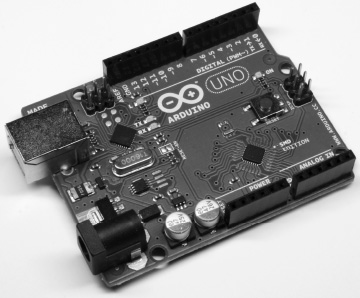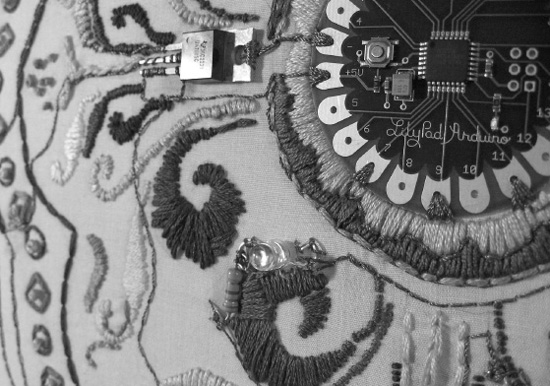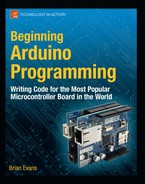Arduino is for Makers
Arduino is a flexible programmable hardware platform designed for artists, designers, tinkerers, and the makers of things. Arduino’s little, blue circuit board, mythically taking its name from a local pub in Italy, has in a very short time motivated a new generation of DIYers of all ages to make all manner of wild projects found anywhere from the hallowed grounds of our universities to the scorching desert sands of a particularly infamous yearly arts festival and just about everywhere in between. Usually these Arduino-based projects require little to no programming skills or knowledge of electronics theory, and more often than not, this handiness is simply picked up along the way.
Central to the Arduino interface board, shown in Figure 1-1, is an onboard microcontroller—think of it as a little computer on a chip.

Figure 1-1. The Arduino Uno interface board, 2011
This microcontroller comes from a company called Atmel and the chip is known as an AVR. It is slow in modern terms, running at only 16Mhz with an 8-bit core, and has a very limited amount of available memory, with 32 kilobytes of storage and 2 kilobytes of random access memory. The interface board is known for its rather quirky design—just ask the die-hards about standardized pin spacing—but it also epitomizes the minimalist mantra of only making things as complicated as they absolutely need to be. Its design is not entirely new or revolutionary, beginning with a curious merger of two, off-the-shelf reference designs, one for an inexpensive microcontroller and the other for a USB-to-serial converter, with a handful of other useful components all wrapped up in a single board. Its predecessors include the venerable BASIC Stamp, which got its start as early as 1992, as well as the OOPic, Basic ATOM, BASIC-X24, and the PICAXE.
Where all of these precursors are generally closed proprietary products and often require a single computer platform to use, the Arduino development environment is free for all to use and will run on just about any kind of computer that supports Java. The actual hardware board costs a mere USD $30 or EUR €22 and needs nothing more complex than a USB cable to get up and running. This affordable price, nearly half that of its closest competitor, and the board’s durable design have led to numerous Arduino-like boards being stitched into embroidery (see Figure 1-2), embedded in pumpkins to be launched through the air by trebuchets, and even sent into outer space in weather balloons.

Figure 1-2. LilyPad Arduino embroidery, courtesy Becky Stern, sternlab.org
This at least tells us a little bit about what kind of person the Arduino was originally designed for and about the hardware used in its design, but these things alone do not begin to account for the huge degree of success enjoyed by the Arduino as a whole. To get a sense for this popularity, we need to look at the larger Arduino ecosystem and how some fairly divergent parts came together to create a movement.
